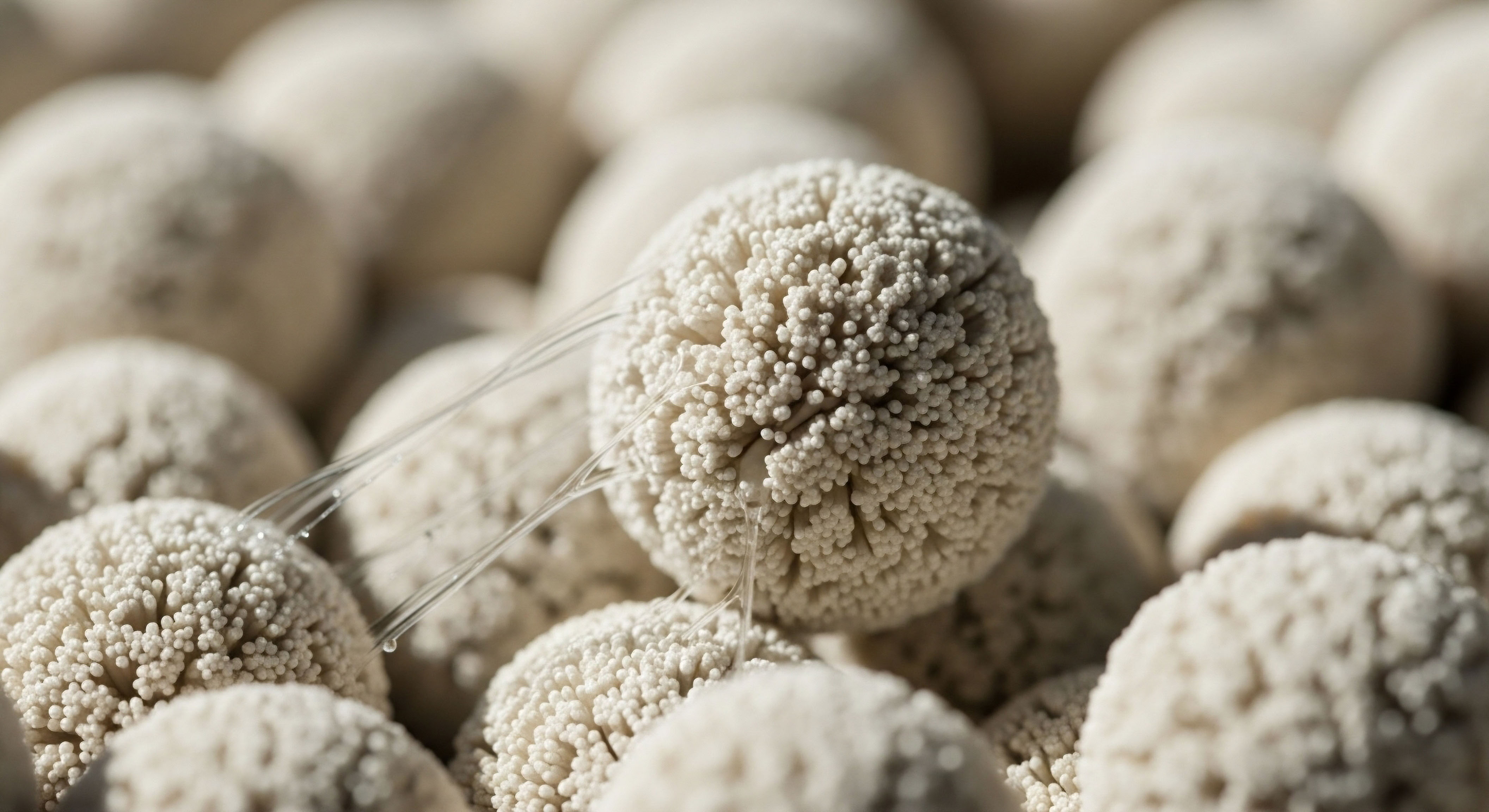

Fundamentals
Your journey toward hormonal recalibration begins with a profound commitment to yourself. You have engaged with the clinical process, interpreted your biological data, and now hold a small vial containing a specific peptide sequence, a molecule engineered to guide your body toward a state of enhanced function.
This vial represents a significant investment in your well-being. The quiet potential held within that lyophilized powder, whether it is Sermorelin to optimize sleep architecture or BPC-157 for tissue repair, depends entirely on how it is handled from this moment forward. Protecting its integrity is the first and most immediate step in realizing the benefits of your protocol. The science of storage is the science of safeguarding potential.
Peptides are precise biological messengers, constructed from chains of amino acids. Their structure is their function. Imagine a perfectly crafted key, designed to fit a specific lock within your body’s cellular machinery. If that key is bent, rusted, or broken, it will fail to open the lock.
The principal threats to a peptide’s structure are temperature, light, and moisture. These environmental factors act as forces that can bend and break that key, rendering it ineffective long before it has a chance to perform its intended role. Your refrigerator and freezer are your primary tools in defending against this degradation, creating a controlled environment where these molecular messengers can rest, undisturbed and intact, until they are called upon.
The stability of a peptide is directly linked to the preservation of its delicate three-dimensional structure.
You will encounter peptides in two distinct states ∞ lyophilized and reconstituted. Each state has its own set of storage requirements, grounded in its relative vulnerability to degradation.

Understanding Lyophilized Peptides
The peptide arrives as a lyophilized powder, a state achieved through freeze-drying. This process removes water, placing the peptide into a state of suspended animation. In this dry, powdered form, it is remarkably stable. The absence of water dramatically slows down chemical reactions that would otherwise degrade the molecule.
However, it remains vulnerable. For short-term storage, spanning a few weeks, a standard refrigerator at a temperature of 4°C provides a safe environment. For long-term storage, the gold standard is a freezer set at -20°C or colder. At these sub-zero temperatures, molecular motion is minimized, effectively pausing the process of degradation for months or even years.

Key Principles for Lyophilized Storage
- Temperature For periods extending beyond a few months, store lyophilized peptides at -20°C or colder to ensure maximum shelf life.
- Moisture The lyophilized powder is hygroscopic, meaning it readily absorbs moisture from the air. It is vital to keep the vial tightly sealed. Allow the vial to reach room temperature before opening it to prevent condensation from forming inside.
- Light Exposure to UV light can fracture peptide bonds. Always store the vials in their original box or a dark container to shield them from light.

The Transition to Reconstituted Peptides
Reconstitution is the process of adding a solvent, typically bacteriostatic water, to the lyophilized powder, bringing the peptide back into a liquid, active state. This step is transformative. While it prepares the peptide for administration, it also removes the protective shield of lyophilization.
The reintroduction of water awakens the peptide’s chemical reactivity, making it far more susceptible to degradation. Once reconstituted, the peptide’s lifespan shortens considerably. It must be stored in a refrigerator at 2-8°C and is typically viable for a few weeks. Freezing a reconstituted peptide is generally discouraged due to the physical damage that can occur during the freeze-thaw process.
| Peptide State | Primary Storage Location | Typical Temperature Range | General Shelf Life |
|---|---|---|---|
| Lyophilized (Powder) | Freezer | -20°C or below | Months to Years |
| Reconstituted (Liquid) | Refrigerator | 2°C to 8°C | Weeks |


Intermediate
Having grasped the foundational principles of peptide preservation, you are now prepared to engage with the practical mechanics of handling these molecules within the context of a clinical protocol. The transition from a stable powder to an active solution is a critical juncture where precision and technique are paramount.
This is the point where you, the individual, become the primary steward of the peptide’s efficacy. Your protocol, whether it involves daily injections of Ipamorelin/CJC-1295 for growth hormone optimization or targeted use of PT-141 for sexual health, relies on the biological activity of the solution you prepare. The following procedures are designed to maintain that activity with clinical exactitude.

The Art and Science of Reconstitution
Reconstitution is a delicate procedure that demands a sterile environment. The objective is to dissolve the lyophilized powder without compromising the peptide’s structure or introducing contaminants. Bacteriostatic water, which contains 0.9% benzyl alcohol, is the standard solvent. This small amount of alcohol acts as a preservative, inhibiting bacterial growth in the multi-use vial.
The process itself should be methodical. After allowing the peptide vial and bacteriostatic water to reach room temperature, you will gently introduce the water into the peptide vial. The stream of water should be directed against the side of the vial, not directly onto the peptide powder.
This prevents frothing and minimizes physical stress on the molecules. Once the water is added, the vial should be gently swirled or rolled between the hands until the powder is fully dissolved. Vigorous shaking can shear the peptide chains, a form of physical degradation that is just as damaging as chemical breakdown.
Gentle reconstitution is the first active step in preserving a peptide’s therapeutic potential.

Why Is the Freeze-Thaw Cycle Damaging?
Once a peptide is in solution, the temptation might be to freeze it to extend its life. This impulse must be resisted. The process of freezing and thawing a liquid solution is mechanically destructive at a microscopic level. As water freezes, it forms ice crystals.
These crystals have sharp, jagged edges that can physically rupture the delicate peptide structures. When you thaw the solution, the peptides may not refold into their correct, biologically active shape. Each subsequent freeze-thaw cycle inflicts more damage, progressively reducing the potency of the solution.
If you must freeze a reconstituted peptide, it should be done only once. A superior strategy, however, involves careful planning of your reconstitution schedule to align with your protocol’s needs, ensuring the refrigerated liquid is used within its window of stability.

Protocol Management a Practical Example
Let’s consider a common protocol ∞ daily subcutaneous injections of a growth hormone secretagogue blend like Sermorelin or Ipamorelin/CJC-1295. This protocol requires a consistent, daily dose to be effective. The goal is to manage the vial in a way that maximizes potency for the entire duration of its use.
| Day | Action | Storage Location | Rationale |
|---|---|---|---|
| Day 1 (Sunday Evening) | Reconstitute a new vial with bacteriostatic water. Gently swirl to dissolve. | Refrigerator (Front) | Prepares the peptide for the week. Placing it at the front avoids temperature extremes. |
| Day 2-7 (Monday-Saturday) | Clean the vial stopper with an alcohol swab. Draw the prescribed daily dose. | Refrigerator | Maintains sterility and ensures accurate dosing from a stable solution. |
| Throughout the Week | Handle the vial gently. Do not shake or drop it. | Refrigerator | Prevents physical degradation of the peptide molecules in the solution. |
| End of Use Cycle | Discard any remaining solution after the recommended period (e.g. 3-4 weeks). | N/A | Ensures you are always using a solution with optimal potency. |

Traveling with Therapeutic Peptides
Maintaining the cold chain during travel is a logistical challenge that requires planning. For short trips, an insulated medical travel cooler with cold packs is sufficient to keep a reconstituted vial at the correct refrigerator temperature. For longer travel, or when transporting lyophilized vials, the same principles of temperature control and protection from light apply.
It is always wise to consult airline regulations regarding the transport of medical liquids and syringes. Keeping your peptides in their original packaging with prescription information can facilitate a smooth security screening process. The effort taken to maintain the cold chain directly translates to the uninterrupted continuation of your protocol and its intended physiological benefits.


Academic
A comprehensive understanding of peptide stability extends into the realm of biochemistry, where the specific mechanisms of molecular degradation can be examined. The guidelines for storage are empirical best practices derived from a deep knowledge of the chemical vulnerabilities inherent in peptide structures.
Peptides are not inert compounds; they are dynamic molecules susceptible to a range of reactions that can cleave bonds, alter side chains, and ultimately nullify their biological function. The two most consequential degradation pathways under typical storage conditions are hydrolysis and oxidation. Understanding these processes at a molecular level provides the ultimate rationale for the meticulous handling protocols required in a clinical setting.

Hydrolytic Degradation Pathways
Hydrolysis is the cleavage of a chemical bond by the addition of water. In a reconstituted peptide solution, water is abundant, creating a constant chemical pressure on the peptide’s backbone and side chains. Two forms of hydrolytic degradation are particularly relevant.

Deamidation
Deamidation is a reaction that specifically affects amino acid residues with amide-containing side chains, namely asparagine (Asn) and glutamine (Gln). The asparagine residue is particularly susceptible. The side-chain amide group can undergo an intramolecular cyclization reaction, forming a five-membered succinimide ring intermediate.
This intermediate is then rapidly hydrolyzed, yielding either aspartic acid or its isomer, isoaspartic acid. This conversion is significant because it replaces a neutral, polar side chain with a negatively charged one, altering the peptide’s local structure, overall charge, and ability to bind to its receptor. This single chemical change can completely inactivate the peptide. The rate of deamidation is highly dependent on pH and the specific amino acids adjacent to the asparagine residue.

Peptide Bond Cleavage
The peptide bonds that form the backbone of the molecule can also be subject to hydrolysis, particularly at aspartic acid (Asp) residues. The bond following an aspartic acid residue is known to be up to 100 times more labile than other peptide bonds. This reaction, known as acid-catalyzed hydrolysis, can fragment the peptide into smaller, inactive pieces.
The pH of the solution is a dominant factor in the rate of this degradation, which is why the formulation of a peptide solution, including the use of specific buffers, is a critical aspect of pharmaceutical development.
The chemical stability of a peptide in solution is a constant battle against the inherent reactivity of its constituent amino acids with water.

Oxidative Degradation Pathways
Oxidation involves the loss of electrons and is another primary route of peptide degradation. It is primarily driven by atmospheric oxygen, trace metal ions, and exposure to light. Certain amino acid residues are highly prone to oxidation.
The most susceptible residues include methionine (Met), cysteine (Cys), tryptophan (Trp), histidine (His), and tyrosine (Tyr). Methionine is readily oxidized to form methionine sulfoxide, a modification that adds a bulky, polar oxygen atom and can drastically alter the peptide’s conformation and function. Cysteine residues are unique in their ability to form disulfide bonds with each other.
While these bonds are often a natural part of a peptide’s structure, uncontrolled oxidation can lead to the formation of incorrect disulfide bridges or other oxidized sulfur species, leading to aggregation and loss of activity. Storing peptides under an inert gas like argon can mitigate this, but for clinical use, the most practical approach is strict temperature control and protection from light to minimize the energy available to drive these oxidative reactions.

How Do Specific Amino Acid Sequences Dictate Degradation Pathways?
The specific sequence of a peptide is the ultimate determinant of its stability profile. A peptide rich in asparagine and methionine will be highly susceptible to both deamidation and oxidation. For instance, many growth hormone secretagogues, including Sermorelin and its analogues, contain these vulnerable residues.
Their stability is therefore a direct function of mitigating the specific chemical reactions they are prone to. The development of next-generation peptide therapeutics often involves the strategic substitution of these labile amino acids with more stable alternatives to enhance shelf life and robustness without sacrificing biological activity. This ongoing work in medicinal chemistry highlights the deep connection between a peptide’s primary structure and its viability as a therapeutic agent.
- Asparagine (Asn) Prone to deamidation, especially when followed by a small amino acid like glycine. This is a primary concern in liquid formulations.
- Methionine (Met) Highly susceptible to oxidation, converting to methionine sulfoxide. This is a key reason to limit exposure to air and light.
- Cysteine (Cys) Can form improper disulfide bonds or oxidize, leading to aggregation. Requires careful handling to maintain its intended structure.
- Tryptophan (Trp) Susceptible to oxidative degradation, particularly when exposed to light or metal ions.

References
- “The Ultimate Guide to Storing Peptides ∞ Best Practices for Maximum Potency & Longevity.” Dripdok Help Center, Intercom.
- “Ultimate Guide to Peptide Storage ∞ Frozen, Room Temp, and Reconstituted Stability Explained.” Reddit, r/PeptideGuide, 20 March 2025.
- “How to Store Peptides | Best Practices for Researchers.” Peptide World.
- “Peptide Calculator.” Particle Peptides.
- “Handling and Storage Guidelines for Peptides.” Bachem AG.

Reflection

Calibrating Your Personal Protocol
The knowledge you have acquired about the chemical life of peptides is more than a set of instructions. It is an expansion of your ability to actively participate in your own wellness protocol. The vial you hold is a tool, and understanding its physical nature allows you to wield that tool with greater precision and respect.
The meticulous acts of storing, reconstituting, and handling these molecules are extensions of the commitment you have already made to your health. Each step, from allowing a vial to warm to room temperature to the gentle swirl that brings it into solution, is a mindful action that honors the science behind your protocol.
This detailed awareness transforms the process from a simple task into a deliberate practice, ensuring that the potential for renewal contained within each dose is delivered to your body, fully intact and ready to perform its biological function. Your journey is unique, and the care you bring to it is the most important component of all.

Glossary

lyophilized powder

sermorelin

amino acids

lyophilized peptides

bacteriostatic water

ipamorelin

cjc-1295

peptide stability

degradation pathways

oxidation

deamidation




